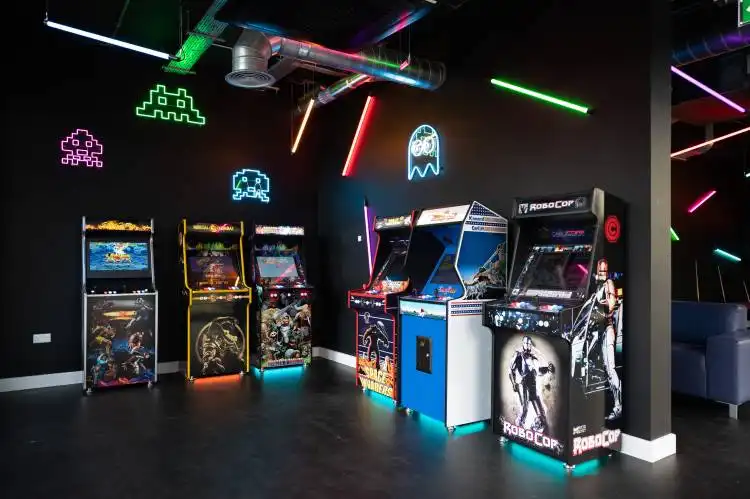Start a Board Game Cafe
Turning 'Fun and Games' into a Profitable Business Venture
| Updated


BOARD GAME CAFE
Welcome to the exciting intersection of fun and business - a Board Game Cafe! This ever-growing industry marries the love of board games with the comforting allure of a cozy cafe environment. As a business, it functions by providing a vast collection of games, a welcoming space for play, and enticing food and drink for customers' enjoyment. Just imagine, your future venture is set to involve more "Connect Four" and cappuccinos than cluttered desks and tri-fold reports!
Jump to Business Plan
RELATED BUSINESS IDEAS
Browse ALL Hospitality & Leisure Ventures Business Ideas
Discover Your Perfect Domain
Unlock the door to your online success with our hand-picked selection of premium domain names. Whether you're starting a new venture or rebranding an existing one, the right domain can set the tone for your digital presence. Browse through our curated list, each with its unique potential to enhance your brand's visibility and credibility.
BOARD GAME CAFE MINI BUSINESS PLAN
This a quick reality check to help you identify the strengths and weaknesses of your business concept before you dive in.
Business Idea: Board Game Cafe
Here is a simplified potential financial outlook for a Board Game Cafe:
Expected Percent Margin:
- Gross Margin: 70-80% (Including Board Games Rental, Food & Beverage Sales)
- Net Profit Margin: 10-15%
Earnings Expectations:
- Daily Earnings: $300 - $600
- Weekly Earnings: $2,100 - $4,200
- Monthly Earnings: $9,000 - $18,000
- Annual Earnings: $108,000 - $216,000
Actions to Hit Those Numbers:
Board Games Inventory:
- Initial Investment: At least $5,000-$10,000 for diverse, quality fun board games.
- Hit Games and Classics: The collection should have a combination of hit new games and nostalgic classics.
Food & Beverage:
- Menu: An attractive combination of refreshments and simple dishes that customers can enjoy while playing.
Marketing and Customer Acquisition:
- Social Media: Regular posts and updates about new games, events, discounts, etc.
- Events: Hosting weekly/monthly themed game nights or tournaments.
Experience & Service:
- Staff Training: Staff should be well-versed with the rules of popular board games to assist new customers.
- Comfortable Environment: The place should be furnished comfortably for long hours of gaming.
Cost Control:
- Rent & Utilities: Strategically select a location to keep rent and utility costs under control.
- Inventory Management: Regular stock check to avoid wastage in food & beverage segment.
Remember, local market conditions can greatly affect the profitability of this kind of business, so this is just a generalized projection. Always make sure to do market research and consult with a financial advisor.
NOT WHAT YOU HAD IN MIND? Here are more ideas



Browse ALL Hospitality & Leisure Ventures Business Ideas
Grab Your Business Website Name
Before you get caught up in the whirlwind of setting up your business, invest in a domain name. It's a small but significant step that lays the foundation for your brand and makes it easier for customers to find and trust you. Just like you wouldn't build a house without securing the land first, don't build a business without securing your domain name.
"Why? Can't that wait?" Here's why it shouldn't
Step 1: Determine if the Business is the Right Endeavor
Breakdown of Startup Expenses
Before starting a board game cafe, it is important to understand the costs associated with getting the business up and running. This includes the cost of renting or purchasing a space, purchasing furniture and equipment, obtaining necessary licenses and permits, and hiring staff. Additionally, the cost of purchasing board games, snacks, and drinks should be taken into consideration. It is important to have a thorough understanding of the startup costs before starting the business.
Breakdown of Ongoing Expenses
It is also important to consider the ongoing expenses associated with running a board game cafe. This includes rent or mortgage payments, utilities, insurance, salaries, and other overhead costs. Additionally, the cost of restocking board games, snacks, and drinks should be taken into consideration. It is important to have a thorough understanding of the ongoing expenses before starting the business.
Examples of Ways to Make Money
There are several ways to make money with a board game cafe. For example, customers can pay an hourly fee to play board games, or they can purchase snacks and drinks from the cafe. Additionally, the cafe can host tournaments and special events, or offer memberships for discounted rates. It is important to have a thorough understanding of the different ways to make money before starting the business.
Step 2: Name the Business
- Brainstorm Ideas: Start by brainstorming ideas for the name of the business. Think of words that are related to board games, cafes, and fun. Consider using alliteration or puns to make the name stand out.
- Research Names: Once you have a few ideas, research to make sure the name is not already taken. Check domain names, social media handles, and other businesses to make sure the name is unique.
- Get Feedback: Ask friends and family for their opinion on the name. This can help you determine if the name is memorable and if it accurately reflects the business.
- Finalize the Name: Once you have chosen the name, make sure to register it with the appropriate authorities. This will help protect the name and ensure that it is legally yours.
Brainstorming ideas for the name of the business is the first step in naming the business. Think of words that are related to board games, cafes, and fun. Consider using alliteration or puns to make the name stand out. For example, a board game cafe could be named “Game Night Galore” or “The Board Room”. Once you have a few ideas, research to make sure the name is not already taken. Check domain names, social media handles, and other businesses to make sure the name is unique. Additionally, ask friends and family for their opinion on the name. This can help you determine if the name is memorable and if it accurately reflects the business. Finally, once you have chosen the name, make sure to register it with the appropriate authorities. This will help protect the name and ensure that it is legally yours.
Step 3: Obtain Necessary Licenses and Permits
Researching Local Regulations
Before you can open your board game cafe, you must research local regulations. This includes researching zoning laws, health codes, and other regulations that may apply to your business. You should also check with your local government to see if there are any special licenses or permits you need to obtain. This can help you avoid any potential legal issues down the line.
Obtaining Necessary Licenses and Permits
Once you have researched the local regulations, you can begin the process of obtaining the necessary licenses and permits. This may include obtaining a business license, a food service license, and any other permits that may be required. Depending on your location, you may also need to obtain a liquor license if you plan to serve alcohol. Additionally, you may need to obtain a fire safety permit and a building permit if you plan to make any changes to the building. Make sure to contact your local government to find out what licenses and permits you need to obtain.
Step 4: Secure a Location
Factors to Consider When Choosing a Location
When selecting a location for a board game cafe, it is important to consider the size, accessibility, and cost of the space. The size of the space should be large enough to accommodate the number of customers you expect to serve, as well as the board games and other amenities you plan to offer. Additionally, the space should be easily accessible for customers, with convenient parking and public transportation options. Finally, the cost of the space should be within your budget.
Negotiating a Lease
Once you have identified a suitable location, it is important to negotiate a lease that works for both you and the landlord. When negotiating a lease, consider the length of the lease, the cost of the rent, and any additional fees that may be associated with the space. Additionally, consider any restrictions that may be placed on the use of the space, such as restrictions on noise or hours of operation. Finally, be sure to read through the lease carefully and ask questions if anything is unclear.
Step 5: Design the Space
Design Considerations
When designing the space for a board game cafe, it is important to consider the layout of the cafe, the furniture, and the overall atmosphere. The cafe should have enough seating for guests to comfortably play board games, as well as enough tables for guests to purchase food and drinks. It is also important to consider the lighting and sound of the cafe, as this can help create a pleasant atmosphere for guests. Additionally, it is important to consider the overall aesthetic of the cafe, as this will help create a memorable experience for guests.
Working with an Interior Designer
When designing the space for a board game cafe, it is important to work with an interior designer who can help create a space that is both aesthetically pleasing and functional. An interior designer will be able to help create a space that is tailored to the needs of the cafe, as well as help create a unique atmosphere that will draw guests in. Additionally, an interior designer will be able to help create a space that is both comfortable and inviting for guests. Furthermore, an interior designer can help create a space that is both cost-effective and efficient.
Step 6: Purchase Equipment and Supplies
Necessary Equipment and Supplies
When starting a board game cafe, it is important to purchase the necessary equipment and supplies. This includes tables and chairs, board games, and other gaming supplies. It is also important to have a point of sale system, such as a cash register or a tablet, to process payments. Additionally, you will need to purchase items such as cups, napkins, and utensils for customers.
Sources for Purchasing Equipment and Supplies
When purchasing equipment and supplies for your board game cafe, it is important to shop around for the best prices. Many online retailers offer discounts on bulk orders, so it is important to compare prices and find the best deal. Additionally, you may be able to find used equipment and supplies at local thrift stores or online auction sites. Finally, you may be able to find suppliers who specialize in board game cafe equipment and supplies.
Step 7: Market the Business
Developing a marketing plan is essential to the success of any business. A marketing plan should include a detailed analysis of the target market, the competitive landscape, and the most effective marketing strategies. It should also include a budget and timeline for implementation.
Developing a Marketing Plan
When developing a marketing plan, it is important to understand the target market. This includes researching the demographics of potential customers and the competitive landscape. It is also important to consider the most effective marketing strategies for the business. This could include traditional advertising, such as television and radio commercials, or digital marketing, such as social media campaigns and email newsletters.
Examples of Effective Marketing Strategies
Traditional advertising is a great way to reach a wide audience. Television and radio commercials can be used to reach a large number of people in a short amount of time. Digital marketing can also be effective, as it allows for more targeted campaigns. Social media campaigns can be used to reach a specific demographic, while email newsletters can be used to keep customers informed about new products and promotions. Additionally, word-of-mouth marketing can be a powerful tool for any business. Encouraging customers to share their experiences with friends and family can be a great way to spread the word about the business.
Step 8: Hire Employees
- Research the job market: Before you begin the hiring process, it is important to research the job market to determine the types of employees you need and the qualifications they should possess.
- Create a job description: Once you have determined the type of employees you need, create a detailed job description that outlines the job duties, qualifications, and expectations.
- Post the job listing: Once you have created the job description, post the job listing on job boards, social media, and other outlets to attract potential employees.
- Interview candidates: After you have received applications, interview the candidates to determine if they are the right fit for the job. Ask questions about their experience, qualifications, and work ethic.
- Make an offer: After you have interviewed the candidates, make an offer to the one you feel is the best fit for the job. Be sure to include details about the salary, benefits, and other perks.
- Onboard new employees: After you have hired the new employee, onboard them by providing training and resources to help them succeed in their new role.
Step 8: Hire Employees Hiring employees is an important step in starting a board game cafe. Before you begin the hiring process, it is important to research the job market to determine the types of employees you need and the qualifications they should possess. This research should include looking at job postings for similar businesses in the area, as well as researching the local job market to determine the types of employees that are in demand. Once you have determined the type of employees you need, create a detailed job description that outlines the job duties, qualifications, and expectations. This job description should be clear and concise, and should include any special qualifications or certifications that are necessary for the position.
Once you have created the job description, post the job listing on job boards, social media, and other outlets to attract potential employees. Be sure to include details about the job, such as the salary, benefits, and other perks. After you have received applications, interview the candidates to determine if they are the right fit for the job. Ask questions about their experience, qualifications, and work ethic to get a better understanding of their skills and abilities. After you have interviewed the candidates, make an offer to the one you feel is the best fit for the job. Be sure to include details about the salary, benefits, and other perks.
Finally, after you have hired the new employee, onboard them by providing training and resources to help them succeed in their new role. This should include providing them with an orientation to the business, as well as any necessary training or certifications. Additionally, provide them with resources such as manuals, guidelines, and other materials to help them understand their job duties and expectations. By providing new employees with the necessary resources and training, you can ensure they are well-prepared to succeed in their new role.
Step 9: Open the Business
Before opening the business, it is important to make sure that all the necessary steps have been taken. This includes making sure that all permits and licenses have been obtained, that all necessary insurance policies are in place, and that all employees have been hired and trained. Additionally, it is important to make sure that all the necessary equipment and supplies have been purchased and that the space is ready for customers. It is also important to make sure that the business has a strong online presence, with a website, social media accounts, and a listing on local business directories. Finally, it is important to make sure that all the necessary marketing materials have been created and distributed.
EXPLORE MORE CATEGORIES
Browse ALL Business Idea Categories
TAKE THE NEXT STEPS










